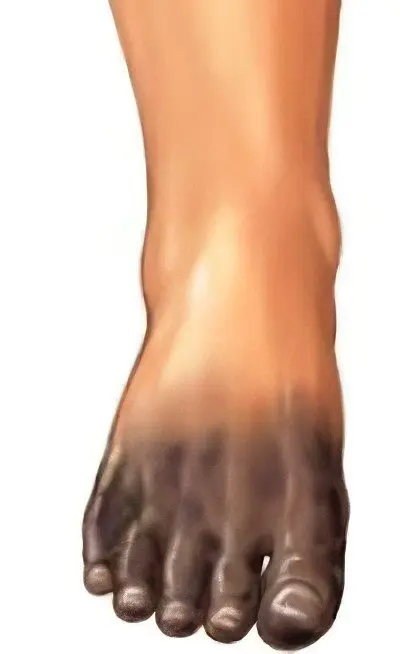Necrosis of the legs

Necrosis is a destructive process. It is characterized by swelling, loss of the form of the protein molecule (denaturation), thickening of cytoplasmic proteins, destruction of cell organelles. As a result of these changes, the cell dies. According to the etiology, necrosis of the lower extremities is rheumatic, toxigenic, trophoneurotic and ischemic.
The main cause of tissue necrosis is a malnutrition of any part of it due to trauma or putrefactive inflammation, and most often this occurs with a combination of these factors. Such a pathology develops due to the impact on the cells of mechanical force (shocks, ruptures, fractures), developing infection, high or low temperatures.
Usually, necrosis of any part of the limbs is gangrene, it is dry, wet and gas. Dry is considered more favorable. With wet gangrene, the general manifestations are much more pronounced. Necrotic phenomena can spread rapidly depending on the continuation of the mechanical influence, the addition of infection and the anatomical and physiological characteristics of the person.
The beginning of the manifestation of the development of necrosis is characterized by severe pain, sensations of numbness appear, sensitivity is lost, and motor functions are impaired. Paleness of the skin is noted, it becomes cold and takes on a marbled appearance, later the skin becomes bluish, and then begins to turn green or black. Patients complain of rapid fatigue of the legs, constant freezing, regardless of the time of year.
Seizures may occur. The presence of non-healing sores is also a signal of the onset of gangrene. The death of tissue cells begins from the lower parts of the leg, gradually spreading, necrosis reaches the part where the malnutrition occurred. A demarcation line is formed at the border of dead and living tissues, which allows the surgical removal of the dead part of the leg along this line or above it.
This is the main tactic worked out by surgeons over the years, it is the only correct method. Treatment of such patients is aimed at maintaining the general condition. It is necessary to restore the volume and composition of the extracellular and intracellular water space of the body. For this, blood, blood substitutes, antibiotics, vitamins, etc. are injected.
Gas gangrene can be provoked by a special group of microbes. After infection, spores are formed in the wound, which quickly develop into tissues with impaired oxygen supply. This type of gangrene rapidly destroys muscle tissue. Microbes secrete substances that contribute to the breakdown of proteins and carbohydrates of necrotic tissues. A feature of this process is the release of gas. Gas gangrene flows painfully, the area of infection swells. Wounds exude a foul-smelling liquid. The skin around the wound darkens, cracks when pressed. Without surgery, gas gangrene cannot be cured. The entire affected area is removed or the limb is amputated.
Necrosis of the foot and toe
Necrosis of the foot can develop with an advanced stage of an ulcer or an uncontrolled infection in its place. Sudden blockage of a large artery, renal complications, diabetes mellitus also lead to necrosis. Neuropathic causes, i.e., disorders of the somatosensory nervous system, contribute to the appearance of necrotic processes.
Foot gangrene spreads from dead, infected areas. There is dry ischemic gangrene – it proceeds without infection. If the foot is affected by wet gangrene, it is necessary to take antibiotics and constantly conduct microbiological studies. It is possible to achieve positive results from the treatment of foot necrosis only in the conditions of the surgery department.
The treatment process is difficult, intensive measures are necessary, if gangrene is too widespread, only the surgeon can determine the degree of danger, often shunting is the only way to save the foot. In some cases, tactics using plastic techniques and long-term use of antibiotics makes it possible to maintain the function of the foot to a certain extent and, most importantly, can prevent a person’s disability.
In the treatment of patients with severe injuries of the limbs with purulent complications and necrosis of soft tissues and bones, autotransplantation is used – transplantation of the recipient’s own harvested stem cells. Treatment of finger necrosis is based on local treatment, which consists in removing necrosis within healthy tissues. The volume of the removed area depends on the type of necrosis.
In the severe stage, severe intoxication is observed, it is urgent to amputate the finger within healthy tissues (above the level of the necrosis border). It should be borne in mind that more differentiated tissues are affected much faster, therefore, if the skin and muscles of the finger are affected, and the tendons and bone are not affected, only necrotic tissues are excised.









